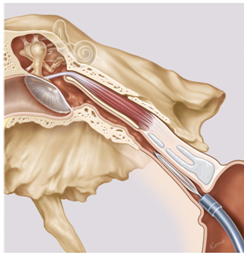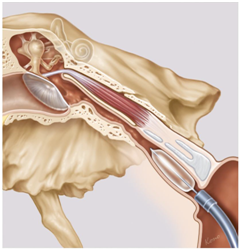The Eustachian tube is a narrow structure running between the air-filled middle ear space and the back of the nose. It is designed to allow ventilation of the middle ear, but in around 5% of the adult population, the tube fails to open adequately, causing many different types of ear disease. In children, Eustachian tube dysfunction is even more common, often causing glue ear and hearing loss. Until recently, we concentrated on treating the consequences of the disease in the ear rather than the underlying defect with the Eustachian tube itself.
Balloon Eustachian Tuboplasty (BET) is a new minimally-invasive technique using a narrow balloon to stretch the Eustachian tube and has recently been used in patients. It appears to be effective at treating conditions caused by poor tube opening. There is much that needs to be understood about how the technique works. In a collaboration between Dr. Michael Sutcliffe in the University Engineering department, and Mr. James Tysome in the ENT Department at Addenbrooke’s Hospital, we plan to study the biomechanics of balloon inflation within human Eustachian tube tissue. In parallel, physical and 3D computer-based models will be created to add to our clinical observations, and provide methods of testing innovative adaptations to the procedure, and new equipment modifications.
The BET procedure: A balloon catheter is inserted into the Eustachian tube via the nose. It is then inflated to a high pressure for two minutes, before being deflated and removed.


| Dr. Michael Sutcliffe |
Department of Engineering |
| Mr. James Tysome |
Consultant ENT Surgeon, Addenbrooke's Hospital |
| Dr. Matthew Smith |
SpR ENT Surgery, Addenbrooke's Hospital |



